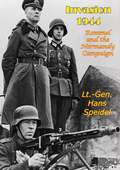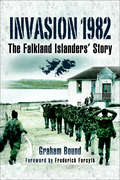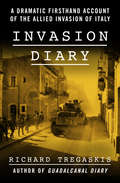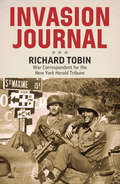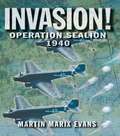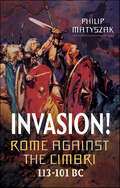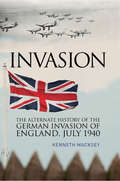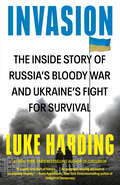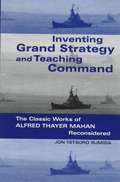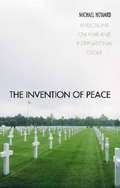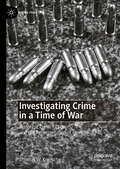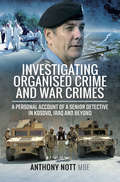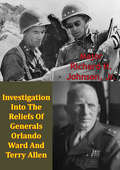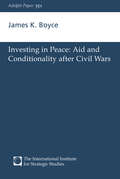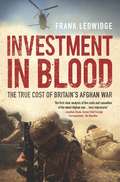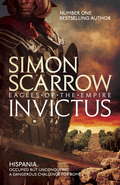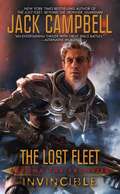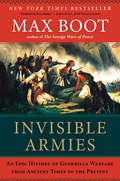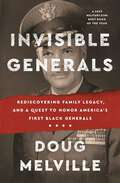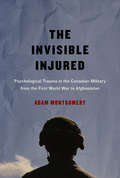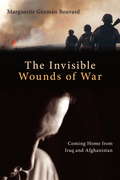- Table View
- List View
Invasion 1944: Rommel and the Normandy Campaign
by Lt.-Gen. Hans Speidel Col. Truman SmithLieutenant-General Hans Speidel's Invasion 1944 tells the story, from the German viewpoint, of one of the most critical periods of World War II. Indeed, to most Americans the summer months of 1944, highlighted by the battles on the Normandy beaches, represent the climax of the world convulsion. Every detail of this epic struggle is today of interest not only to those Americans who participated personally in the battles on the beaches and in the Normandy countryside, but to that still greater number who sweated and bled in Italy, on South Pacific isles, or in the Philippines, or were forced to stay at home. For the Norman beaches have now become a keystone in the arch of American military tradition--worthy to stand alongside Chancellorsville, Appomattox, Château-Thierry and the Meuse-Argonne. Our curiosity, therefore, cannot but be piqued as to what went on in the Château La Roche Guyon, the headquarters of the German Army Group opposing the Allied Normandy armies, as, day by day, American and British pressure brought Hitler's doom nearer.Invasion is by no means merely military history, a record of the estimates and orders of the German Command during the Normandy struggle. This book tells a double story. The battles are the background, while the foreground is dominated by the narrative of another climactic struggle, that between the commander of the Army Group, Erwin Rommel, "the Desert Fox," and his overlord Adolf Hitler."A notable contribution to the...literature on the Normandy campaign. The author was Chief of Staff successively to Rommel, Kluge and Model.... What he has to say about the German defeat is authoritative and of high interest."--New York Herald Tribune Book Review
Invasion 1982: The Falkland Islanders Story
by Graham BoundThe story of British Falkland Islanders under Argentine occupation—with a new chapter on postwar developments: “Reads like a gripping adventure yarn.” —British Heritage MagazineFalkland Islanders were the first British people to come under enemy occupation since the Channel Islanders during the Second World War. This book tells how islanders’ warnings were ignored in London, how their slim defenses gave way to a massive invasion, and how they survived occupation.While some among the small population established a cautiously pragmatic modus vivendi with the occupiers, some islanders opted for active resistance. Others joined advancing British troops, transporting ammunition and leading men to the battlefields. Islanders’ leaders and “troublemakers” faced internal exile, and whole settlements were imprisoned, becoming virtual hostages. A new chapter about Falklands history since 1982 reveals that while the Falklands have benefited greatly from Britain’s ongoing commitment to them, a cold war continues in the south Atlantic. To the annoyance of the Argentines, the islands have prospered—and an oil bonanza promises further riches.Includes a foreword by Frederick Forsyth
Invasion Alienigena - Dentro Del Área 51
by Patrick M MarianoDescripción del libro: Este libro contiene una serie de entrevistas que hice en los Estados Unidos y el Reino Unido. Probablemente soy el primer periodista en acceder al Área 51. Cuando empecé esta investigación, no sabía a dónde me conduciría, pero lo que vi en los niveles subterráneos es realmente aterrador. Si alguna vez se ha preguntado si estamos solos en este universo, la respuesta es no. Los extraterrestres están más cerca de lo que se imagina. He dedicado toda mi vida a informar sobre historias y eventos en los periódicos, y eso es lo que hago para ganarme la vida. No me detendré ahora. Sin embargo, para proteger mi vida, decidí escribir este libro bajo un seudónimo. A lo largo de este libro haré referencia específica a hechos que son claramente reconocibles y que pueden ser consultados. Mi única esperanza es que tomen medidas AHORA y que empiecen a protegerse a ustedes y a las personas que los rodean.
Invasion Diary: A Dramatic Firsthand Account of the Allied Invasion of Italy
by Richard TregaskisA dramatic and richly detailed chronicle of the Allied invasions of Sicily and Italy from one of America&’s greatest war correspondents. Following the defeat of Axis forces in North Africa, Allied military strategists turned their attention to southern Italy. Winston Churchill famously described the region as the &“soft underbelly of Europe,&” and claimed that an invasion would pull German troops from the Eastern Front and help bring a swift end to the war. On July 10, 1943, American and British forces invaded Sicily. Operation Husky brought the island under Allied control and hastened the downfall of Benito Mussolini, but more than one hundred thousand German and Italian troops managed to escape across the Strait of Medina. The &“soft underbelly&” of mainland Italy became, in the words of US Fifth Army commander Lt. Gen. Mark Clark, &“a tough old gut.&” Less than a year after landing with the US Marines on Guadalcanal Island, journalist Richard Tregaskis joined the Allied forces in Sicily and Italy. Invasion Diary documents some of the fiercest fighting of World War II, from bombing runs over Rome to the defense of the Salerno beachhead against heavy artillery fire to the fall of Naples. In compelling and evocative prose, Tregaskis depicts the terror and excitement of life on the front lines and recounts his own harrowing brush with death when a chunk of German shrapnel pierced his helmet and shattered his skull. An invaluable eyewitness account of two of the most crucial campaigns of the Second World War and a stirring tribute to the soldiers, pilots, surgeons, nurses, and ambulance drivers whose skill and courage carried the Allies to victory, Invasion Diary is a classic of war reportage and &“required reading for all who want to know how armies fight&” (Library Journal). This ebook features an illustrated biography of Richard Tregaskis including rare images from the American Heritage Center at the University of Wyoming.
Invasion Journal
by Richard L. TobinInvasion Journal, first published in 1944, is veteran war correspondent Richard Tobin's account of his time in England, aboard several Royal Navy fighting ships, and in France with American G.I.s shortly after the D-Day invasion. Offering interesting insights into English life – the food, morale of the civilians, V-1 bombings – as well as a look at Allied soldiers from its leaders to its soldiers and sailors, Invasion Journal portrays war-time life as it was for millions of people during the heady year of 1944. Of note is his coverage of the broadcasts by the Nazis of the unsuccessful attempt on Hitler's life on July 20, 1944. Tobin (1910-1995) was a reporter, editor, and war correspondent for The New York Herald Tribune from 1932-1956. From 1960-1976 he worked at The Saturday Review as a senior editor and executive.
Invasion!: Operation Sea Lion, 1940
by Martin Marix Evans Angus McgeochThis terrifying alternative reality is actually based on historical facts. The book follows the real course of events up to1 September, including the planning in Britain and Germany, and the aerial war. The fictional story then supposes that the Germans halted their advance in France along the Seine and the Aisne after the fall of Paris and that Marshal Petain conceded an armistice at that point. The Panzer divisions are thus able to rest and re-equip in northern France…A brilliant blend of meticulous research and imagination, this book is bound to appeal to anyone with an interest in the causes and effects of historical events, and indeed to anyone interested in world war history itself.
Invasion!: Rome Against the Cimbri, 113–101 BC
by Philip MatyszakPartly as a result of poor commanders and partly because the Romans had an innate and misguided belief in the invincibility of their legions, the first battles against the Cimbri were a series of disasters. These culminated in the Battle of Arausio in 105 BC when two Roman armies were utterly destroyed. Rome finally realized that their republic faced an existential threat, and made the necessary painful political and military changes that were needed to face that threat. Rome also found a commander who could take on the Cimbri. Caius Marius was a deeply flawed man – scheming, cautious to the point of cowardice, and quick to claim credit for the achievements of others. Nevertheless, he was a massive improvement on the leaders who had preceded him. The reshaped Roman army eventually worked out how to weather the savage onrush of the initial barbarian assault. Thereafter, the grim discipline of the legions was enough to wear down the opposition. It helped that Marius never fought unless the situation favored him, and as a result his army gradually became accustomed to victory. Had the Cimbri overwhelmed Rome, as at one time it seemed inevitable that they would, then European history would have been very different.
Invasion: The Alternative History of the German Invasion of England, July 1940 (Greenhill Military Paperback Ser.)
by Kenneth MackseyThe WWII historian&’s bracingly accurate analysis of what might have happened if Hitler ordered Operation Sea Lion to breech the shores of England. In June 1940, German troops gathered just across the English Channel, poised for the invasion of Britain. With France defeated and Britain cowed, Hitler seemed ready for his greatest gamble. In this compelling alternative history, the Germans launch the invasion that, in reality, was never more than a plan. Landing between Dover and Hythe, German troops push inland supported by the Luftwaffe and the impregnable panzers, and strike out towards London. The British, desperate to defeat the invaders, rally and prepare for a crucial confrontation at Maidstone. Realistic, carefully researched and superbly written, Invasion is a classic of alternate history and a thought-provoking look at how Britain&’s war might have been.&“Macksey&’s blend of what actually happened and what might have been makes for a piece of writing comparable to Frederick Forsyth at his best.&” —Jack Higgins&“Convincingly described and excellently illustrated.&” —The Daily Telegraph, UK
Invasion: The Inside Story of Russia's Bloody War and Ukraine's Fight for Survival
by Luke HardingNew York Times bestselling author of Collusion and The Snowden Files Luke Harding&’s personal, frontline reporting on Russia&’s harrowing invasion of Ukraine, the biggest news event of the year and an inflection point in international politics&“An excellent, moving account of an ongoing tragedy.&” —Anne Applebaum, New York Times bestselling author of Twilight of DemocracyIn a damning, inspiring, and breathtaking narrative of what is likely to be a turning point for Europe—and the world—Guardian correspondent and New York Times bestselling author Luke Harding reports firsthand on the Russian invasion of Ukraine. When, just before dawn on February 24, 2022, Vladimir Putin launched a series of brutal attacks, Harding was there, on the ground in Kyiv. But this senseless violence was met with astounding resilience—from, among others, the country&’s embattled president, Volodymyr Zelenskiy—and the courage of a people preparedi to risk everything to preserve their nation&’s freedom. Here are piercing portraits of the leaders on both sides of this monumental struggle, a haunting depiction of the atrocities in Bucha and elsewhere, and an intimate glimpse into the ordinary lives being impacted by the biggest conflict in Europe since the Second World War. Harding captures this crucial moment in history with candor, insight, and an unwavering focus on the human stories that lie at its heart.
Inventing Grand Strategy and Teaching Command: The Classic Works of Alfred Thayer Mahan Reconsidered
by Jon SumidaJon Sumida is a noted military historian of the 20th century with emphasis on naval developments. The first American works on this subject were those of Alfred T. Mahan and his Influence of Sea Power... books. Though considered out of date in the post WWI naval world, Dr. Sumida provides a new interpretation of these historical works.
Invention of Peace
by Michael HowardThroughout history the overwhelming majority of human societies have taken war for granted and made it the basis for their legal and social structures. Not until the Enlightenment in the eighteenth century did war come to be regarded as an unmitigated evil and one that could be abolished by rational social organization, and only after the massive slaughter of the two world wars did this become the declared objective of civilized states. Nevertheless, war in one form or another continues unabated. In this elegantly written book, a preeminent military historian considers why this is so. Is war in some sense still a necessary element in international order? Are war and peace in fact complementary? Does not peace itself breed the conditions that will ultimately lead to war? And if nuclear weapons have made war ultimately suicidal for mankind, what can be done about it? Having devoted half a century largely to studying these questions, Michael Howard offers us his reflections. Unless they can be answered, he notes, the twenty-first century is unlikely to be any more peaceful than the centuries that preceded it.
Investigating Crime in a Time of War: Historical Crime Fiction and the Representation of Fascism (Crime Files)
by Thomas W. KniescheThis book takes a close look at crime fiction set in the interwar period and during the reign of terror of the Nazi regime. Kniesche analyzes historical crime fiction depicting Weimar and Nazi Germany with specific questions in mind: what does the text try to accomplish in regard to transmitting historical knowledge? What history is told? How is historical knowledge represented and conveyed in crime fiction? Does the historical background provide an indispensable setting for the crime story? With consideration to the degree of self-reflexivity in the texts, Kniesche probes how open the text is to an active participation of the reader in evaluating the historical knowledge that the text itself attempts to provide.
Investigating Organised Crime and War Crimes: A Personal Account of a Senior Detective in Kosovo, Iraq and Beyond
by Anthony NottTony Nott retired from the Dorset Police in 2002 at the rank of superintendent. He had spent most of his service as a detective, and had been involved in the investigation of a number of murder cases and other serious crimes.In 2000 he led the British forensic team on exhumations in Kosovo and describes the horror and brutality carried out by Serb paramilitaries. He then worked in Bosnia for the UN, where he was the commander of the eighty-strong UK police contingent. He describes in detail the investigation of human trafficking for the sex trade and illustrates some conflicting rivalries between the UN and the European Union police mission. He served a year in Iraq between 2004 and 2005 and gives insights into the Shia takeover of the police and other institutions; plus, some unsettling accounts of human rights abuses. He was involved in the investigation into the murder of British aid worker, Margaret Hassan, and is deeply critical about the role played by the UK government. He describes the difficulties he had in dealing with some senior members of the Iraqi Police; in particular, the refusal of a Deputy Minister of Interior, who declined to reopen an investigation into the murder of a British security contractor and four Iraqi citizens. The killers were suspected to be the local police. He then went onto serve two years in Israel and Palestine, where he worked with a US-led team to reform the Palestinian security services in cooperation with a European effort. Whilst this book covers the worst of human behaviour, it also highlights the bravery and triumph of the human spirit, by those ordinary people who were caught up in these events.
Investigation Into The Reliefs Of Generals Orlando Ward And Terry Allen
by Major Richard H. Johnson Jr.Between April and August 1943, the U.S. Army's II Corps saw two of its division commanders relieved of their commands. Each relief appeared tied to battlefield setbacks. MG Orlando Ward of the 1st Armored Division was relieved after his division failed to seize a narrow mountain pass near the town of Maknassy, in Tunisia. Ward's superiors labeled him too cautious, unwilling or unable to motivate his soldiers to take their objective. Months later on the island of Sicily, MG Terry Allen was relieved of command of the 1st Infantry Division. His relief followed the failure to seize the Sicilian town of Troina. Allen's superiors accused him of being too hesitant in committing his entire force to the attack. He was branded an insubordinate rebel who cared only for his own troops.In both cases, a standard history of the events emerged. It was based on the official U.S. Army account and a narrow reading of primary sources. This version of events ascribed each relief to flaws in Ward and Allen's leadership ability. The standard description of the reliefs continues to appear in recent scholarship. However, some accounts departed from the accepted portrayal, and point to alternate reasons behind the reliefs. When these alternative accounts are considered along with a comprehensive examination of primary source material, a new argument emerges. Ward and Allen were removed from command for political and military reasons of expediency. From a broader perspective, this investigation revealed how wartime leaders dealt with unprecedented circumstances to accomplish their goals. Understanding the reliefs of Generals Ward and Allen provides insight into organizational decision making and its effect on the U.S. Army in the early portion of World War II.
Investing in Peace: Aid and Conditionality after Civil Wars (Adelphi series #Vol. 351)
by James K. BoyceThis book analyzes the provision of aid to countries that have undergone negotiated settlements to civil wars, drawing on recent experiences in Bosnia, Cambodia, El Salvador, and Guatemala. It focuses on the potential for peace conditionality, linking aid to steps to implement accords and consolidate the peace. The book explores how aid can encourage domestic investment in peace-related needs; the reconciliation of long-run peacebuilding objectives with short-run humanitarian imperatives; and the obstacles that donors' priorities and procedures pose to effective aid for peace. It concludes that investing in peace requires not only the reconstruction of war-torn societies but also the reconstruction of aid itself.
Investment in Blood
by Frank LedwidgeIn this follow-up to his much-praised book "Losing Small Wars: British Military Failure in Iraq and Afghanistan," Frank Ledwidge argues that Britain has paid a heavy cost - both financially and in human terms - for its involvement in the Afghanistan war. Ledwidge calculates the high price paid by British soldiers and their families, taxpayers in the United Kingdom, and, most importantly, Afghan citizens, highlighting the thousands of deaths and injuries, the enormous amount of money spent bolstering a corrupt Afghan government, and the long-term damage done to the British militarys international reputation. In this hard-hitting expose, based on interviews, rigorous on-the-ground research, and official information obtained through the Freedom of Information Act, Ledwidge demonstrates the folly of Britains extended participation in an unwinnable war. Arguing that the only true beneficiaries of the conflict are development consultants, international arms dealers, and Afghan drug kingpins, he provides a powerful, eye-opening, and often heartbreaking account of military adventurism gone horribly wrong.
Invictus (Eagles Of The Empire Ser. #Bk. 15)
by Simon ScarrowIF YOU DON'T KNOW SIMON SCARROW, YOU DON'T KNOW ROME!The Sunday Times bestseller. INVICTUS is a gripping, authentic and exciting novel of the Roman army from bestselling author Simon Scarrow. Not to be missed by readers of Conn Iggulden and Bernard Cornwell.It is AD 54. The soldiers of the Roman army patrol a growing Empire, from the Mediterranean to the North Sea, from the Atlantic to the banks of the Nile. Rome brutally enforces its rule, and its legions are the most efficient and aggressive fighting force in the world. Two battle-scarred veterans of this army, Prefect Cato and Centurion Macro, have survived years of campaigning in Britannia and have been recalled to Rome. Their time in the teeming, dangerously political city is short, and soon they are travelling with the Praetorian Guard to Spain, a restless colony where simmering tension in the face of Roman rule is aggravated by bitter rivalry amongst the natives. The challenges that face two old friends and their comrades in arms are unlike any they have seen before - in a land that declares itself unconquerable...
Invictus (Eagles of the Empire 15)
by Simon ScarrowThe gripping new Roman adventure in the EAGLES OF THE EMPIRE series, featuring Cato and Macro, from No.1 Sunday Times bestselling Simon Scarrow, author of BRITANNIA and BROTHERS IN BLOOD. 'I really don't need this kind of competition' Bernard Cornwell
Invincible (The Lost Fleet: Beyond the Frontier #2)
by Jack CampbellAdmiral John "Black Jack" Geary was revived from cryogenic sleep to lead the Alliance against the Syndicate Worlds. But his superiors question his loyalty to the regime. Now in command of the First Fleet, he is tasked with exploring the frontier beyond Syndic space, a mission he fears deliberately puts the fleet-- and himself--in harm's way... An encounter with the alien enigmas confirms Geary's fears. Attacked without warning, he orders the fleet to jump star systems--only to enter the crosshairs of another hostile alien armada. Ignoring the First Fleet's peaceful communications, this species sends its ships into battle while it guards the exiting jump point with a fortress of incalculable power. Now Geary must find a way to reach the jump point without massive casualties--even though the enigmas could be waiting on the other side...
Invisible Armies: An Epic History of Guerrilla Warfare from Ancient Times to the Present
by Max Boot"Destined to be the classic account of what may be the oldest . . . hardest form of war."--John Nagl, Wall Street Journal Invisible Armies presents an entirely original narrative of warfare, which demonstrates that, far from the exception, loosely organized partisan or guerrilla warfare has been the dominant form of military conflict throughout history. New York Times best-selling author and military historian Max Boot traces guerrilla warfare and terrorism from antiquity to the present, narrating nearly thirty centuries of unconventional military conflicts. Filled with dramatic analysis of strategy and tactics, as well as many memorable characters--from Italian nationalist Guiseppe Garibaldi to the "Quiet American," Edward Lansdale--Invisible Armies is "as readable as a novel" (Michael Korda, Daily Beast) and "a timely reminder to politicians and generals of the hard-earned lessons of history" (Economist).
Invisible Generals: Rediscovering Family Legacy, and a Quest to Honor America's First Black Generals
by Doug MelvilleThis amazing true story of America&’s first Black generals, Benjamin O. Davis Sr. and Jr., a father and son who helped integrate the American military and created the Tuskegee Airmen, is &“the book Black America needs in this moment&” (Eboni K. Williams, lawyer and cohost of State of the Culture).Red Tails, George Lucas&’s celebration of America&’s first Black flying squadron, the Tuskegee Airmen, should have been a moment of victory for Doug Melville. He expected to see his great-uncle Benjamin O. Davis Jr.—the squadron&’s commander—immortalized on-screen for his selfless contributions to America. But as the film rolled, Doug was shocked when he realized that Ben Jr.&’s name had been omitted and replaced by the fictional Colonel A. J. Bullard. And Ben&’s father, Benjamin O. Davis Sr., America&’s first Black general who helped integrate the military, was left out completely. Dejected, Doug looked inward and realized that unless he worked to bring their inspirational story to light, it would remain hidden from the world just as it had been concealed from him. In this &“thoughtful, highly readable blend of family and military history&” (Kirkus Reviews), Melville shares his quest to rediscover his family&’s story across five generations, from post-Civil War America to modern day Asia and Europe. In life, the Davises were denied the recognition and compensation they&’d earned, but through his journey, Melville uncovers something greater: that dedication and self-sacrifice can move proverbial mountains—even in a world determined to make you invisible. Invisible Generals recounts the lives of a father and his son who always maintained their belief in the American dream. As the inheritor of their legacy, Melville retraces their steps, advocates for them to receive their long-overdue honors and unlocks the potential we all hold to retrieve powerful family stories lost to the past.
Invisible Injured: Psychological Trauma in the Canadian Military from the First World War to Afghanistan
by Adam MontgomeryCanadian soldiers returning home have always been changed by war and peacekeeping, frequently in harmful but unseen ways. The Invisible Injured explores the Canadian military’s continuous battle with psychological trauma from 1914 to 2014 to show that while public understanding and sympathy toward affected soldiers has increased, myths and stigmas have remained. Whether diagnosed with shell shock, battle exhaustion, or post-traumatic stress disorder, Canadian troops were at the mercy of a military culture that promoted stoic and manly behaviour while shunning weakness and vulnerability. Those who admitted to mental difficulties were often ostracized, released from the military, and denied a pension. Through interviews with veterans and close examination of accounts and records on the First World War, the Second World War, and post-Cold War peacekeeping missions, Adam Montgomery outlines the intimate links between the military, psychiatrists, politicians, and the Canadian public. He demonstrates that Canadians’ views of trauma developed alongside the nation’s changing role on the international stage – from warrior nation to peacekeeper. While Canadians took pride in their military’s accomplishments around the globe, soldiers who came back haunted by their experiences were often ignored. Utilizing a wide range of historical sources and a frank approach, The Invisible Injured is the first book-length history of trauma in the Canadian military over the past century. It is a timely and provocative study that points to past mistakes and outlines new ideas of courage and determination.
Invisible Injured: Psychological Trauma in the Canadian Military from the First World War to Afghanistan (McGill-Queen's/Associated Medical Services Studies in the History of Medicine, Health, and Society #46)
by Adam MontgomeryCanadian soldiers returning home have always been changed by war and peacekeeping, frequently in harmful but unseen ways. The Invisible Injured explores the Canadian military’s continuous battle with psychological trauma from 1914 to 2014 to show that while public understanding and sympathy toward affected soldiers has increased, myths and stigmas have remained. Whether diagnosed with shell shock, battle exhaustion, or post-traumatic stress disorder, Canadian troops were at the mercy of a military culture that promoted stoic and manly behaviour while shunning weakness and vulnerability. Those who admitted to mental difficulties were often ostracized, released from the military, and denied a pension. Through interviews with veterans and close examination of accounts and records on the First World War, the Second World War, and post-Cold War peacekeeping missions, Adam Montgomery outlines the intimate links between the military, psychiatrists, politicians, and the Canadian public. He demonstrates that Canadians’ views of trauma developed alongside the nation’s changing role on the international stage – from warrior nation to peacekeeper. While Canadians took pride in their military’s accomplishments around the globe, soldiers who came back haunted by their experiences were often ignored. Utilizing a wide range of historical sources and a frank approach, The Invisible Injured is the first book-length history of trauma in the Canadian military over the past century. It is a timely and provocative study that points to past mistakes and outlines new ideas of courage and determination.
Invisible Women: Junior Enlisted Army Wives
by Margaret C. HarrellMilitary manpower policy is often crafted by policymakers without an in-depth understanding of the life experiences and views of junior enlisted personnel. It is plausible to expect that some policymakers attribute the attitudes and experiences of these young soldiers to such features as youth or lack of an advanced education and may thus believe themselves able to empathize with this population group by recalling their own parallel life experiences. However, this approach oversimplifies the life experiences of these families and neglects the reality that most policymakers and professional managers have never experienced the compendium of problems these couples face, such as youth, lack of education, financial difficulties, emotional and physical distance from extended family, and invisibility in a large bureaucracy. At the center of this book are the personal stories of three junior enlisted spouses, told in their own voices and selected to emphasize the dilemmas numerous enlisted families face. The stories provide insight into the experiences and attitudes of other junior enlisted families. Those interested or involved in the military, or those who live a military lifestyle--at any pay grade--will find these stories both useful and engaging.
Invisible Wounds of War: Coming Home from Iraq and Afghanistan
by Marguerite Guzman Bouvard<p>There’s no real homecoming for many of our veterans returning from the wars in Iraq and Afghanistan. They may go through the motions of daily life in their hometowns, but the terrible sights and sounds of war are still fresh in their minds. <p>This empathic, inside look into the lives of our combat veterans reveals the lingering impact that the longest wars in our nation’s history continue to have on far too many of our finest young people. Basing her account on numerous interviews with veterans and their families, the author examines the factors that have made these recent conflicts especially trying. <p>A major focus of the book is the extreme duress that is a daily part of a soldier’s life in combat zones with no clear frontlines or perimeters. Having to cope with unrecognizable enemies in the midst of civilian populations and attacks from hidden weapons like improvised explosive devices exacts a heavy toll. Compounding the problem is the all-volunteer nature of our armed forces, which often demands multiple deployments of enlistees. This results in frequent cases of post-traumatic stress disorder and families disrupted by the long absence of one and sometimes both parents. <p>The author also discusses the lack of connectedness between civilian society and military personnel, leading to inadequate healthcare for many veterans. This deficiency has been highlighted by the urgent need to treat traumatic brain injuries in survivors of explosions and the high veteran suicide rate. <p>Bouvard concludes on a positive note by discussing some of the surprising and encouraging ways that the chasm between civilian and military life is being bridged to help reintegrate our returning soldiers. For veterans, their families, and especially for civilians unaware of how much our soldiers have endured, <i>The Invisible Wounds of War</i> is important reading.</p>
